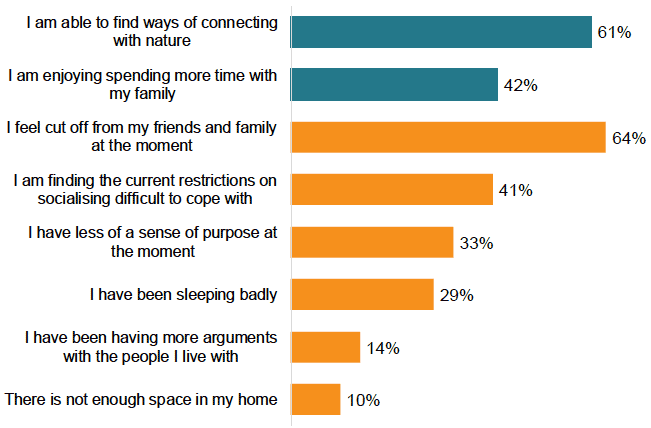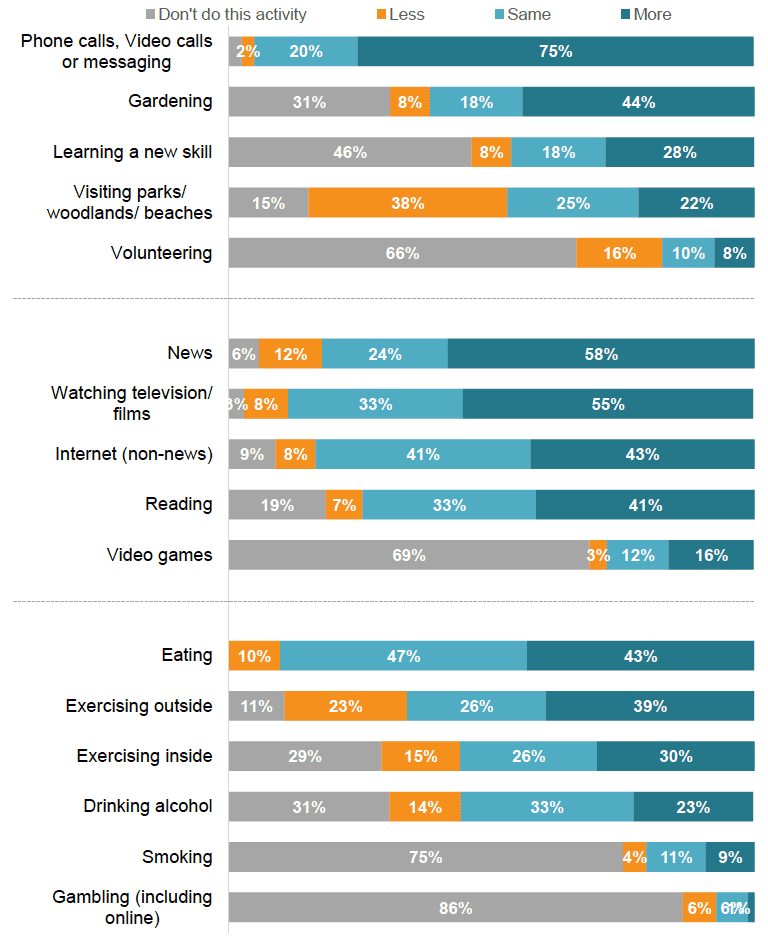Coronavirus (COVID-19): impact on wellbeing - research
This report contains the findings from a telephone survey commissioned by Scottish Government to better understand the impact of the COVID-19 pandemic on people in Scotland.
Chapter 3. Coping and activities during lockdown
To understand how respondents have coped with the lockdown period, they were asked a series of questions about their amenities and activities.
Greenspace access
Respondents were asked what, if any, greenspace they had access to within a 10-15 minute walk. As shown in Figure 18, the majority of respondents had access to a private garden (81%) or another open space (78%).

Base: All (1000)
Figure 18 Description
This bar chart shows the proportion of respondents who indicated they have access to the following greenspace: ‘Private Garden’, ‘Shared Garden’, ‘A balcony, terrace or rooftop’, ‘Another open space, like a park, beach, wood, canal or river path’, or ‘None of these’. It shows that 81% of respondents have access to a private garden, while 78% had access to another open space like a park, etc.
Subgroup differences - greenspace access with 10-15 minutes
Although the majority of respondents had access to greenspace, those aged 35-54 and 55-69 were more likely to have a private garden (both 86%) than those in the younger age groups (63% of 16-24 year olds and 76% of 25-34 year olds). Those in the oldest age group (70+) were also more likely to have a private garden (84%) than those aged 16-24 (63%). However, those aged 16-24, 35-54 and 55-69 were more likely to have access to another open space (84%, 83% and 78%) than those in the 70+ age group (65%).
Those in less deprived areas were more likely to have access to greenspace. In particular, those in the two least deprived areas were more likely to have access to a private garden (85% and 90% respectively) than those in the most and second most deprived areas (69% and 77% respectively). Those in the least deprived areas were also more likely to have access to another open space (84%) than those in the two most deprived (both 73%).
Disabled respondents were also more likely to have access to another open space (82%) than those who were not disabled (66%).
Coping
To understand how well respondents were coping during the pandemic, respondents were asked which statements from a provided list applied to them. As shown in Figure 19, the majority of respondents were feeling cut off from their friends and family (64%). Four in ten (41%) were finding the current restrictions on socialising difficult to cope with, while around a third felt they had less of a sense of purpose at the moment (33%) and a similar proportion were sleeping badly (29%). A minority (14%) were having more arguments with the people they live with: with their husband, wife or partner (55%), children or step-children (34%), their parent (19%), another family member (11%) or a housemate (3%).
However, the majority (61%) were also finding ways of connecting with nature, while 42% were enjoying spending more time with their family.

Base: All (1000)
Figure 19 Description
This bar chart shows the proportions of respondents who felt the following statements applied to them: ‘I am able to find ways of connecting with nature’, ‘I am enjoying spending more time with my family’, ‘I feel cut off from my friends and family at the moment’, ‘I am finding the current restrictions on socialising difficult to cope with’, ‘I have less of a sense of purpose at the moment’, ‘I have been sleeping badly’, ‘I have been having more arguments with the people I live with’ and ‘There is not enough space in my home’. This chart shows the most common response was ‘I feel cut off from my friends and family at the moment’, with 64% of respondents agreeing with this, followed by 61% of respondents who indicated they are ‘able to find ways of connecting with nature.
Subgroup differences - coping statements
Women were more likely than men to be feeling cut off from family and friends (70% compared with 58%), finding restrictions on socialising difficult to cope with (47% compared with 35%) and sleeping badly (36% compared with 22%).
Younger age groups were more likely to be having difficulty than older groups. Those in the three youngest age groups (16-24, 25-34 and 35-54) were more likely than the two older groups (55-69 and 70+) to be having more arguments with the people they live with (26%, 17% and 17% compared with 6% and 5%) and to not have enough space in their home (15%, 14% and 14% compared with 3% and 4%).
However, those aged 16-24, 25-34 and 35-54 were more likely to say they were enjoying spending more time with their family (40%, 59% and 57% respectively) than those aged 55-69 (25%) and 70+ (14%).
Those in households with children were more likely to say they were enjoying spending time with their family (75% compared with 28%), that there was not enough space in their home (16% compared with 7%) and that they were arguing more with the people they live with (21% compared with 10%) than those without children.
Those in the most deprived areas were also more likely to report not having enough space in their home (15%) than those in the two least deprived areas (both 7%). Meanwhile, those in the two least deprived areas were more likely to report being able to find ways of connecting with nature (70% and 75% respectively) than the three most deprived areas (48%-57%).
Disabled respondents reported more difficulties coping than those who were not disabled, including; feeling cut off from family with friends (75% compared with 61%), finding current restrictions on socialising difficult to cope with (55% compared with 37%), and having less of a sense of purpose (47% compared with 29%). In addition, disabled respondents were more likely to report sleeping badly (47% compared with 25%) and not having enough space in their home (18% compared with 8%).
Change in activities
Respondents were asked what activities, shown in Figure 20, they had been engaging in more, less or the same since the start of March. The list was presented whole to respondents, with items grouped into three areas for analysis.
Social activities and hobbies
As shown in Figure 20, the majority of respondents were phoning, video calling and messaging family and friends more (75%), whilst 44% were gardening more and 28% learning a new skill more than they were previously. Around a fifth were visiting parks, woodlands or beaches more (22%), though 38% were now doing this less.
Media and entertainment consumption
Respondents were asked about the media they had been consuming, and how this compared to the start of March. As shown in Figure 20, the majority of respondents were watching the news (58%) and television and films (55%) more, while around two-fifths were reading and using the internet more than previously (41% and 43% respectively).
Health and exercise behaviours
Respondents were asked about differences in their health behaviours compared with the start of March. As shown in Figure 20, substantial minorities were eating more (43%) and drinking alcohol more (23%), while around one in ten (9%) were smoking more.
Furthermore, as shown in Figure 20, substantial minorities were also exercising more than previously, both outside (39%) and inside (30%). However, around a quarter (23%) were exercising outside less, while 15% were exercising inside less.

Base: All (1000)
Figure 20 Description
This cluster bar chart shows 16 different activities, and for each activity shows the proportion of respondents who answered they are doing this ‘More’, ‘Same’, ‘Less’ or ‘Don’t do this activity’ since the start of March. The activities in the chart are: ‘Phone calls, Video calls or messaging’, ‘Gardening’, ‘Learning a new skill’, ‘Visiting parks/ woodlands/ beaches’, ‘Volunteering’, ‘News’, ‘Watching television/ films’, ‘Internet (non-news)’, ‘Reading’, ‘Video games’, ‘Eating’, ‘Exercising outside’, ‘Exercising inside’, ‘Drinking alcohol’, ‘Smoking’, ‘Gambling including online’. It shows that 75% of respondents are phone calling more, and 58% are watching the news more. It also shows that 38% are visiting parks less and 23% exercising outside less.
Subgroup differences - social activities and hobbies
Women were more likely than men to be phoning, video calling and messaging family and friends more (80% compared with 71%), while men were more likely to be visiting parks, woodlands and beaches more (26% compared with 19%).
Those in rural areas were more likely to be gardening more (60%) than those in urban areas (41%).
Those in the three least deprived areas were more likely to be phoning, video calling and messaging family and friends more (76%-81%) than those in the most deprived areas (62%). People living in these areas were also more likely to be gardening more (44%, 54% and 51%) than those in the most deprived (32%). Furthermore, those in the least deprived areas were more likely to be visiting parks, woodlands and beaches more (26%) than those in the second most deprived (17%).
Disabled respondents were more likely to be visiting parks, woodlands and beaches less often compared with March (46%) than non-disabled respondents (35%).
Subgroup differences - media and entertainment consumption
Men were more likely to be playing video games more compared with the start of March (25%) than women (8%), while women were more likely to be consuming news more (61%) than men (55%).
Those in younger groups were playing video games more; 40% of those aged 16-24 and 30% of those aged 25-34 were doing this more compared with 14% of those aged 35-54, 3% of those aged 55-69 and 4% of those aged 70+. Those aged 16-24 were also more likely to be watching television or films more (72%) than those aged 35-54, 55-69 and 70+ (55%, 51% and 40% respectively). Conversely, those aged 55-69 and 70+ were more likely to be reading more (46% and 49% respectively) than those aged 16-24 (31%)
Those in urban areas were more likely to be playing video games more often (18%) than were those in rural areas (12%).
Subgroup differences - health and exercise behaviours
Women were more likely than men to be eating more compared with the start of March (50% compared with 36%), while men were more likely to report eating the same amount (54% compared with 41%). Men were also more likely than women to report gambling less than previously (11% and 3% respectively).
Those aged 25-34 and 35-54 were more likely to be eating more (50% and 51% respectively) than those aged 55-69 (37%), while 15% of those aged 16-24, compared with 5% of those aged 70+, were eating less. Those in the younger and middle age groups were also more likely to be drinking alcohol more (24%, 24% 28% and 20% respectively) than those aged 70+ (11%).
As shown in Table 4, those in younger age groups were also more likely to be exercising more, both indoors and outdoors.
| Age | Exercising outside more | Exercising indoors more |
|---|---|---|
| 16-24 | 56% | 47% |
| 25-34 | 40% | 37% |
| 35-54 | 38% | 29% |
| 55-69 | 41% | 27% |
| 70+ | 25% | 14% |
Base: 16-24 (127) 25-34 (150) 35-54 (325) 55-69 (255) 70+ (143)
Those in the three most deprived areas were more likely to be smoking more than previously (11%-15%) than those in the two least deprived (both 5%). Meanwhile, those in the least deprived areas were more likely to be exercising outside more than previously (47%) compared with those in the three most deprived (34%-36%).
Disabled respondents were more likely to report eating less (21% compared with 7%), while non-disabled respondents were more likely to report eating the same amount (49% compared with 39%). Non-disabled respondents were also more likely to be exercising outside more (43%) than those who were disabled (27%).
Contact
Email: socialresearch@gov.scot
There is a problem
Thanks for your feedback